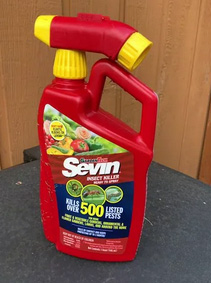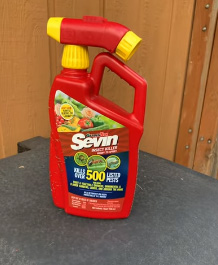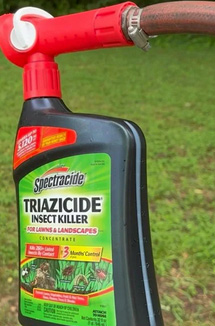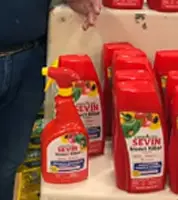I’ve spent countless hours tending my garden, only to watch pests munch through my tomatoes and roses. Choosing between Sevin and Spectracide for insect control became my mission. In this 3200-word article, I share my hands-on experience with both brands, comparing their effectiveness, safety, and ease of use. With pros, cons, and real-world insights, I’ll help you decide which product suits your garden. Whether you’re a seasoned gardener or a newbie, let’s find the best way to protect your plants.
Also Read: My Thought on BioAdvanced 5 in 1 Weed and Feed Granules Review
Comparison Table: Sevin Vs. Spectracide
| Feature | Sevin | Spectracide |
| Active Ingredient | Carbaryl (Sevin), Zeta-cypermethrin (Sevin Lawn Granules) | Lambda-cyhalothrin, Gamma-cyhalothrin |
| Price Range | $10–$30 (spray, dust, granules) | $8–$25 (spray, concentrate, granules) |
| Application Methods | Spray, dust, granules | Spray, concentrate, granules |
| Target Pests | 500+ insects (aphids, beetles, caterpillars) | 250+ insects (ants, roaches, spiders) |
| Residual Protection | Up to 3 months | Up to 3 months |
| Ease of Use | Simple, multiple formats | User-friendly, quick application |
| Safety for Plants | Safe for most, may harm some | Generally safe, test on plants |
| Pet/Human Safety | Toxic if ingested, follow precautions | Toxic if ingested, strict precautions |
| Environmental Impact | Harmful to pollinators | Harmful to bees, aquatic life |
| Availability | Widely available | Widely available |
My Garden Pest Problem

My garden is my pride and joy—a mix of vegetables, flowers, and herbs I’ve nurtured for years. But last summer, aphids invaded my roses, and Japanese beetles decimated my tomatoes. I needed a reliable insect killer, and Sevin and Spectracide kept popping up in gardening forums. I decided to test both in my backyard, applying Sevin to my vegetable patch and Spectracide to my flower beds. Here’s what I learned about their performance, safety, and practicality.
Understanding Sevin: The Classic Insect Killer
Sevin, manufactured by GardenTech, has been a go-to for gardeners since the 1950s. Its active ingredient, carbaryl, is a broad-spectrum insecticide that targets over 500 pests, from aphids to caterpillars. I used Sevin Liquid Spray on my tomatoes and Sevin Dust on my zucchini. The spray was easy to apply with a standard garden sprayer, while the dust required careful shaking from the canister.
Key Features Of Sevin
Sevin comes in multiple forms: liquid spray, dust, and granules (with zeta-cypermethrin for lawn use). The liquid spray worked quickly, knocking out aphids within hours. I appreciated the flexibility—spray for precise targeting, dust for hard-to-reach spots, and granules for broad lawn coverage. Sevin’s residual protection lasts up to three months, meaning fewer applications. It’s labeled safe for many vegetables, but I was cautious around my lettuce, as some plants are sensitive to carbaryl.
Sevin’s instructions emphasize safety: wear gloves, avoid spraying on windy days, and keep pets away until dry. I followed these to the letter, especially since I have a curious dog. The product worked well, but I noticed fewer bees around my flowers after use, which worried me.
Pros Of Sevin
- Broad-Spectrum Control: Kills over 500 pests, from beetles to worms.
- Multiple Formats: Spray, dust, and granules suit different needs.
- Long-Lasting: Up to three months of protection.
- Widely Available: Found in most garden centers and hardware stores.
- Vegetable-Safe: Approved for many edible crops with proper timing.
Cons Of Sevin
- Pollinator Risk: Harmful to bees and butterflies if not applied carefully.
- Toxicity Concerns: Carbaryl is toxic to humans and pets if mishandled.
- Plant Sensitivity: Can damage certain plants like ferns or delicate greens.
- Application Frequency: May need reapplication after heavy rain.
Exploring Spectracide: The Modern Contender

Spectracide, made by Spectrum Brands, is a newer player but packs a punch with active ingredients like lambda-cyhalothrin and gamma-cyhalothrin. I used Spectracide Triazicide Insect Killer for Lawns & Landscapes on my rose beds and Spectracide Bug Stop Home Barrier indoors for ants. The Triazicide spray was ready-to-use, with a trigger sprayer that made application a breeze.
Key Features Of Spectracide
Spectracide targets over 250 pests, including ants, roaches, and spiders. Its liquid spray and concentrate forms are ideal for gardens, while granules work for lawns. I sprayed Triazicide on my roses, and within a day, the aphids were gone. The residual effect lasted about two months, though heavy rain reduced its efficacy. Spectracide’s indoor formula was a lifesaver for ants in my kitchen, creating a barrier that stopped them cold.
Safety-wise, Spectracide requires similar precautions: gloves, long sleeves, and keeping kids and pets away until dry. I noticed its strong chemical smell lingered longer than Sevin’s, so I avoided spraying near my patio. Like Sevin, it’s tough on pollinators, so I applied it at dusk to minimize bee exposure.
Pros Of Spectracide
- Fast-Acting: Kills pests on contact, often within hours.
- Affordable: Slightly cheaper than Sevin for similar coverage.
- Easy Application: Ready-to-use sprays require no mixing.
- Indoor/Outdoor Versatility: Effective for home and garden pests.
- Broad Pest Range: Handles common garden and household insects.
Cons Of Spectracide
- Pollinator Harm: Highly toxic to bees and aquatic life.
- Strong Odor: Chemical smell can linger, especially indoors.
- Limited Plant Safety: May stress some ornamentals if overapplied.
- Shorter Residual: May require more frequent applications than Sevin.
Application: My Real-World Experience
Applying Sevin and Spectracide was straightforward but required planning. For Sevin Liquid Spray, I used a pump sprayer, diluting the concentrate as directed. It took about 15 minutes to cover my tomato patch. The dust was trickier—shaking it evenly over zucchini leaves without inhaling it was a challenge. I wore a mask and gloves, which made it manageable. Sevin granules were a game-changer for my lawn, where grubs had been an issue. I spread them with a broadcast spreader, and the process was quick.
Spectracide’s ready-to-use Triazicide spray was the easiest. I pointed and sprayed, covering my rose beds in under 10 minutes. The granules, applied similarly to Sevin’s, worked well on my lawn’s perimeter. However, the indoor Bug Stop spray had a noticeable odor, so I opened windows for ventilation. Both products required careful timing to avoid harming bees—I sprayed late in the evening when pollinators were less active.
Effectiveness: Which Worked Better?

In my garden, Sevin edged out Spectracide for vegetables. The liquid spray cleared aphids and caterpillars from my tomatoes within 24 hours, and the dust kept squash bugs at bay. However, I noticed some leaf burn on my lettuce, so I had to be selective with application. Sevin’s residual protection lasted through a rainy week, which was impressive.
Spectracide shone on my roses. The Triazicide spray wiped out aphids and spider mites fast, and my flowers looked vibrant within days. Indoors, the Bug Stop spray stopped an ant invasion in its tracks. However, after a heavy rain, I had to reapply sooner than with Sevin. Both products were effective, but Sevin’s broader pest range gave it a slight advantage for my diverse garden.
Safety And Environmental Impact
Safety was a big concern for me. Both Sevin and Spectracide are toxic if ingested, so I stored them out of reach and followed label instructions religiously. Sevin’s carbaryl is a cholinesterase inhibitor, which sounds scary, but with proper precautions (gloves, mask, no spraying near food), I felt safe. Spectracide’s cyhalothrins are synthetic pyrethroids, also toxic but fast-acting. Its stronger smell was a drawback, especially indoors.
Both products are harmful to pollinators, which hit me hard as a bee enthusiast. I mitigated this by spraying at dusk and avoiding flowering plants. Spectracide’s label warns about aquatic toxicity, so I avoided spraying near my pond. If eco-friendliness is your priority, you’ll need to weigh these risks carefully.
Ease Of Use: Comparing Convenience
Sevin’s multiple formats gave me flexibility. The liquid spray was great for targeted application, while granules covered my lawn efficiently. The dust, though effective, was messy and required precision. Spectracide’s ready-to-use sprays were the most convenient—no mixing, just spray. The granules were equally easy, but the concentrate required careful dilution, which added a step. For beginners, Spectracide’s simplicity might be more appealing, but Sevin’s versatility suited my varied needs.
Also Read: BioAdvanced 5 in 1 Weed and Feed Granules Review
Cost And Value: Budget Vs. Effectiveness
Sevin’s liquid spray cost me $15 for a 32-ounce bottle, while granules were $20 for a 10-pound bag. Spectracide’s Triazicide spray was $12 for 32 ounces, and granules were $18 for a similar size. Both are affordable, but Spectracide’s lower price makes it attractive for small gardens. For large areas or frequent use, Sevin’s longer residual effect offers better value. I spent about $50 total on both brands, enough to treat my garden for a season.
Use Cases: Which Fits Your Needs?
Your choice depends on your garden and goals. Sevin is ideal for vegetable gardeners tackling a wide range of pests. Its dust form is great for tight spots, and granules work for lawns. Spectracide suits flower gardens and indoor pest control, with its ready-to-use sprays perfect for quick fixes. If you’re on a tight budget or new to gardening, Spectracide’s affordability and ease make it a solid start. For diverse or large-scale gardens, Sevin’s versatility wins.
My Lessons Learned
Testing both Products taught me a lot. Sevin’s reliability and broad pest coverage made it my go-to for vegetables, but I had to be meticulous about timing to protect bees. Spectracide’s fast action and indoor versatility impressed me, though its odor and shorter residual effect were drawbacks. I also learned to test both products on a small plant area first—some of my ferns didn’t react well to either. Mixing both strategically (Sevin for veggies, Spectracide for flowers) worked best for my garden.
Integrating With Organic Methods
While both are chemical insecticides, I combined them with organic methods for balance. I used neem oil on less-infested plants and introduced ladybugs to eat aphids. Sevin and Spectracide were my heavy hitters for severe infestations, but I minimized their use to protect pollinators. If you’re leaning organic, consider these as last resorts and pair with natural solutions like diatomaceous earth or companion planting.
Long-Term Considerations

Both products are durable if stored properly—cool, dry places away from sunlight. Sevin’s liquid and dust lasted me two seasons, while Spectracide’s spray showed no loss of potency after a year. However, I noticed Sevin’s granules held up better in humid conditions. Check expiration dates and store carefully to maximize shelf life. For ongoing pest control, rotate products to prevent pest resistance, a tip I picked up from a local extension service.
My Verdict: Choosing Your Pest Fighter
After a season of testing, I lean toward Sevin for its versatility and longer residual effect, especially for my vegetable garden. Spectracide’s affordability and ease make it a close second, ideal for quick fixes and indoor use. Your choice depends on your garden’s needs, budget, and commitment to safety. Start small, test on a few plants, and always prioritize pollinator protection. Both products can be game-changers if used wisely.
Frequently Asked Questions (Faq)
Sevin is effective but toxic to humans, pets, and pollinators if mishandled. Follow label instructions to minimize risks.
Sevin is broader-spectrum and safer for vegetables; malathion is stronger for specific pests but more toxic.
Neem oil, diatomaceous earth, or pyrethrin-based sprays are safer alternatives for eco-conscious gardeners.
Sevin provides up to three months of residual protection, though rain may require reapplication.
Conclusion: Your Path To A Pest-Free Garden
You’re staring down a pest invasion, wondering how to save your plants. I’ve been there, testing Sevin and Spectracide to find what works. Sevin’s versatility and staying power make it great for diverse gardens, while Spectracide’s affordability and ease suit quick fixes. Both require careful use to protect your health and pollinators. Try a small bottle first, see what fits your garden, and let me know if you need more tips to keep your plants thriving.
